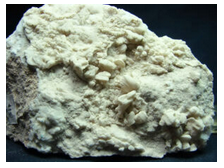14.7.5: Nitrate Group Minerals
- Page ID
- 18677
Nitratite (Soda Niter) NaNO3
Origin of Name
Nitratite is one of the two more common nitrate minerals.

Hand Specimen Identification
Softness, distinctive “cooling” taste, habit, and solubility help identify nitratite. It is typically found in thin layers or coatings deposited by efflorescence in dry environments. It is deliquescent (absorbs water and becomes liquid) under humid conditions.
Physical Properties
| hardness | 1 to 2 |
| specific gravity | 2.29 |
| cleavage/fracture | perfect but rarely seen rhombohedral {104}/conchoidal |
| luster/transparency | vitreous/transparent to translucent |
| color | colorless |
| streak | white |
Properties in Thin Section
Nitratite is uniaxial (-), ω = 1.587, ε = 1.336, δ = 0.251.
Crystallography
Nitratite is a trigonal mineral. a = 5.07, c = 16.82, Z = 6; space group \(R\overline{3}\dfrac{2}{c}\); point group \(\overline{3}\dfrac{2}{m}\).
Habit
Individual nitratite crystals have a rhombohedral habit, but nitratite is often too fine grained or too massive for crystals to be easily seen. It sometimes forms as a crust.
Structure and Composition
Nitratite, the sodium analogue of niter (saltpeter; KNO3), is isostructural with calcite. Na and NO3 replace for Ca2+ and CO, respectively in calcite. Nitratite is always nearly pure, forming very limited solid solution with niter (saltpeter).
Occurrence and Associations
Because nitratite is highly soluble in water, it is only found in arid regions where it may be associated with other evaporite minerals.
Related Minerals
The only other common nitrate is niter (saltpeter).
Niter (Saltpeter) KNO3
Origin of Name
Niter is the second most common nitrate mineral, and is quite rare.

Hand Specimen Identification
Softness, salty taste, habit, and high solubility in water help identify this mineral.
Physical Properties
| hardness | 2 |
| specific gravity | 2.10 |
| cleavage/fracture | perfect but rarely seen rhombohedral {011}/uneven |
| luster/transparency | vitreous/translucent |
| color | white |
| streak | white |
Properties in Thin Section
Niter is biaxial (-), a = 1.333 , β = 1.505, γ = 1.505, δ = 0.172, 2V = 7°.
Crystallography
Niter is orthorhombic, a = 5.43, b = 9.19, c = 6.46, Z = 4; space group \(P\dfrac{2_1}{c}\dfrac{2_1}{m}\dfrac{2_1}{n}\); point group \(\dfrac{2}{m}\dfrac{2}{m}\dfrac{2}{m}\).
Habit
Niter is most common as crusts and coatings or fine dusty aggregates. When visible, niter crystals are typically acicular.
Structure and Composition
Niter is isostructural with aragonite. It forms minor solid solutions with nitratite.
Occurrence and Associations
Niter is found in arid-region soils and unconsolidated sediments in caves.
Related Minerals
Eight or nine nitrate minerals are known, but all except niter and nitratite are extremely rare.


